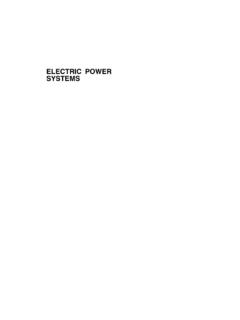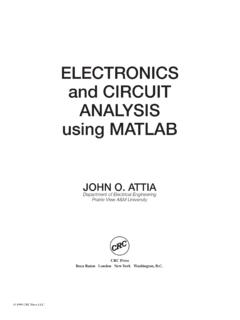Transcription of 3. Diodes and Diode Circuits
1 3. Diodes and Diode CircuitsTLT-8016 Basic Analog Circuits2005/200613. Diodes and Diode Circuits3. Diodes and Diode CircuitsTLT-8016 Basic Analog Circuits2005 Diode CharacteristicsSmall-Signal DiodesDiode: a semiconductor device, which conduct the current in one direction terminals: anodeand the positive polarity is at the anode the Diode is forward biasedand is the positive polarity is at the cathode the Diode is reversed biasedand is not the reverse-biasing voltage is sufficiently large the Diode is in reverse-breakdownregion and large current flows though Semiconductor Diodes and Diode CircuitsTLT-8016 Basic Analog Circuits2005/20063 Figure Volt-ampere characteristic for a typical small-signal silicon Diode at a temperature of 300 K. Notice the changes of DiodesZener Diodes : doides intended to operate in breakdown breakdown voltage > 6V:avalanche breakdown voltage < 6V:tunneling mechanism of drop across the Diode when forward biased: current though the Diode when reversed biased: ~ 1nA(10-9A)Temperature dependence: As the temperature increases, the voltage of the knee decreases by 2mV/K.
2 The reverse current doubles for each 10K increase in the Zenerdiode Diodes and Diode CircuitsTLT-8016 Basic Analog Circuits2005 The Ideal - Diode Model Ideal Diode : perfect conductor with zero voltage drop when the Diode is forward biased; open circuit , when the Diode is reversed Ideal- Diode volt-ampere Diodes and Diode CircuitsTLT-8016 Basic Analog Circuits2005/20065 Assumed States for analysis of Ideal - Diode CircuitsExample circuit Solution By Assumed Diode StatesAnalyze the circuit illustrated in Figure using the ideal - Diode Step 1. We start by assuming that D1 is off and D2is 2. The equivalent circuit is shown in Figure iD2= and vD1= 3. We have vD1=+7V, which is not consistent with our AssumptionStep 1. We assume that D1 is on and D2is 2. The equivalent circuit is shown in Figure iD1=1 mAand vD2= -3 V. Step 3. These conditions are consistent with the analysis of a Diode circuit using the ideal- Diode model.
3 3. Diodes and Diode CircuitsTLT-8016 Basic Analog Circuits2005/20066 Exercise that the condition D1 on and D2on is not valid for the circuit of the Figure that the condition D1 off and D2off is not valid for the circuit of the Figure +-+-10V4k ++--vD1vD23V6k +-+-10V4k 3 ViD1iD2iD1+iD2 Equivalent circuit to Figure when D1is on and D2is circuit to Figure when D1is off and D2is () = = +== == =+DDDDDDD iiiiiiiSolutionvD1= 10V; vD2= 3V. The both Diodes must be on since the voltages across them are negative sign of iD2means that it flows in the opposite direction to the assumed, from the cathode to the anode of D2. This is Diodes and Diode CircuitsTLT-8016 Basic Analog Circuits2005 Rectifier CircuitsRectifiers: Circuits , which convert ac power into dc -Wave Rectifier CircuitsFigure Half-wave rectifier with resistive Diodes and Diode CircuitsTLT-8016 Basic Analog Circuits2005/20068 Half -Wave Rectifier with Smoothing CapacitorFigure Half-wave rectifier with smoothing & c Half-wave rectifier with smoothing Inverse VoltagePeak inverse voltage(PIV) across the Diode : a parameter, which defines the choice of the Figure PIV = Vm; For Figure PIV Diodes and Diode CircuitsTLT-8016 Basic Analog Circuits2005/20069 Problem Half-wave battery the battery charging circuit in Figure with Vm= 20V, R= 10 and VB= 14V.
4 Find the peak current assuming an ideal Diode . Also, find the percentage of each cycle in which the Diode is in on state. Sketch vs(t) and i(t) to scale against time.+-RVB+-Current limiting resistorvs(t)Vmsin( t)i(t)Figure Half-wave battery :The Diode is on when ()()14sin20or sin>>tVtVBm The peak current is when the ac voltage is at the peak and is = =RVVIBmmThe wave-shapes of vs(t) and i(t). v, it20V14 Vvs(t)i(t)The Diode is on for 45 t 135 or for 90 of the phase angle. The whole period is 360 , so the Diode is on for time. theof % Diode goes to on state at ()00135 ; ===tt 3. Diodes and Diode CircuitsTLT-8016 Basic Analog Circuits2005/200610 Full -Wave Rectifier CircuitsFigure Diode -bridge full-wave Full-wave Diodes and Diode CircuitsTLT-8016 Basic Analog Circuits2005 Voltage -Regulator CircuitsFigure A voltage regulator supplies constant voltage to a Simple Zener- Diode Voltage RegulatorIn the voltage regulator the zener- Diode operates in the breakdown region, which ensures approximately constant voltage across A simple regulator circuit that provides a nearly constant output voltage from a variable supply Diodes and Diode CircuitsTLT-8016 Basic Analog Circuits2005 Linear Small -Signal Equivalent CircuitsDynamic ResistanceDQDDD vdvdii ( )1 QDDD dvdir( )DDDrvi ( )DDDrvi=( )
5 Figure Diode characteristic, illustrating the Diodes and Diode CircuitsTLT-8016 Basic Analog Circuits2005/200613 The Shockley Equation =1expTDsDnVvIi( )Is saturation current. For small signal Diodes at 300K: Is~ emission coefficient; n= 1 .. 2 for small-signal thermal voltage:qkTVT=( )T absolute temperature in K;k= 10-23J/K the Boltzmann s constant;q= 10-19C the charge of the electron;At T= 300K VT = 26mV3. Diodes and Diode CircuitsTLT-8016 Basic Analog Circuits2005 Basic Semiconductor ConceptsIntrinsic SiliconBohr model of the silicon atom: 14 electrons surround the nucleus; Electron orbits grouped in shells Outermost orbit contains 4 electrons valence shell; Atoms are arranged in crystalline lattice; Each pair of neighbor atoms in the lattice form a covalent bond; The covalent bond consists from two electrons that orbit around the both atoms.
6 Each atom contributes one electron in the pair. At 0K temperature all valence electrons are in bound in the covalence bonds and the conductivity is lattice of intrinsic silicon in the Diodes and Diode CircuitsTLT-8016 Basic Analog Circuits2005/200615 Figure Thermal energy can break a bond, creating a vacancy and a free electron, both of which can move freely through the electronsappear at room temperature due to breaking of the covalent bonds. Only one per 1013bonds is concentration of the free electrons is small, ni 1014free electrons per conductivity is small: Intrinsic silicon crystal (simplified picture in the plane).3. Diodes and Diode CircuitsTLT-8016 Basic Analog Circuits2005/200616 Conduction by HolesGeneration and RecombinationGeneration: breaking the covalent bonds and appearing free electrons and : free electron encounters a higher temperature the rate of the generation is the temperature is constant, the generation and recombination are in As electrons move to the left to fill a hole, the hole moves to the breaking the bond the atom is positive charged and the vacancy of the electron is called the intrinsic silicon the concentration of the electrons niis equal to the concentration of the holes pi:iipn=( )3.
7 Diodes and Diode CircuitsTLT-8016 Basic Analog Circuits2005/200617n-Type Semiconductor MaterialExtrinsic semiconductor:silicon with small concentration of impurities, which change its atom: atom of 5thvalence. Example: phosphorus. The extra valence electron of the phosphorus always is free electron. DNpn+=( )n-type semiconductor:semiconductor with 5thvalence impurities and conductivity, based on the free electrons carriers in n-type silicon: electrons. Minority carriers in n-type silicon: holes. Figure n-type silicon is created by adding valence five impurity Diodes and Diode CircuitsTLT-8016 Basic Analog Circuits2005/200618p-Type Semiconductor MaterialThe Mass -Action LawAcceptor: atom of 3rdvalence. Example: boron. The acceptor atoms always accept an extra electron, creating negative ionized cores and shortage of free electrons. ( )pnNA=+p-type semiconductor:semiconductor with 3rdvalence impurities and conductivity, based on the holes carriers in p-type silicon: holes.
8 Minority carriers in p-type silicon: electrons. Figure p-type silicon is created by adding valence three impurity ( )Since pi= ni2inpn=( )3. Diodes and Diode CircuitsTLT-8016 Basic Analog Circuits2005/200619 Drift The carriers move in random fashion in the crystal due to thermal agitation. If electric field is applied to the random motion is added a constant component. The averaged motion of the charge carriers due to the electric field: drift. Drift velocity is proportional to the electric field the type of the materialIn fabricating the integrated Circuits the impurities are added in stages, changing every time the type of the conductivity ( ) Vnn =( ) Vpp =ADNnNp+=+( ) nis the mobility of the free electrons; pis the mobility of the holes. p< nDiffusionIf there is a difference in the concentration of the charges in the crystal, appears a flow of charges toward the region with small concentration, determining diffusion Diodes and Diode CircuitsTLT-8016 Basic Analog Circuits2005 Physics of the Junction DiodeThe Unbiased pnJunctionFigure If a pnjunction could be formed by joining a p-type crystal to an n-type crystal, a sharp gradient of hole concentration and electron concentration would exist at the junction immediately after joining the Diodes and Diode CircuitsTLT-8016 Basic Analog Circuits2005/200621 Figure Diffusion of majority carriers into the opposite sides causes a depletion regionto appear at the field of depletion region prevents the flow of majority carriers.
9 A built-in barrier potentialexists for them due to depletion region. 3. Diodes and Diode CircuitsTLT-8016 Basic Analog Circuits2005/200622 The pnJunction with Reverse BiasThe pnJunction with Forward BiasForward bias: when the external voltage has opposite polarity to the field of the depletion biasing narrows the depletion region and reduces the barrier potential. When the barrier potential is reduced to 0, a significant current flows through the Under reverse bias, the depletion region becomes bias: when the external voltage has the same polarity as the field of the depletion biasing extends the depletion region and fully stops the current through the Carrier concentration versus distance for a forward biased Diodes and Diode CircuitsTLT-8016 Basic Analog Circuits2005 Switching and High -Frequency Behavior Review of Capacitance( )CVQ=dAC =( )Figure Parallel-plate Diodes and Diode CircuitsTLT-8016 Basic Analog Circuits2005/200624 Depletion CapacitanceDdvdQC=( )()[]mDQj/VCC001 =( )Figure As the reverse bias voltage becomes greater, the charge stored in the depletion region Depletion capacitance versus bias voltage for the 1N4148 Diodes and Diode CircuitsTLT-8016 Basic Analog Circuits2005/200625 Diffusion CapacitanceFigure Hole concentration versus distance for two values of forward =( )3.
10 Diodes and Diode CircuitsTLT-8016 Basic Analog Circuits2005/200626 Complete Small -Signal Diode ModelFigure Small-signal linear Circuits for the pn-junction Diodes and Diode CircuitsTLT-8016 Basic Analog Circuits2005/200627 Large -Signal Switching BehaviorFigure circuit illustrating switching behavior of a pn-junction storage interval;tt transition time;trr reverse recovery time: total time in which the Diode is open after switchingtsrrttt+=( )Figure Waveforms for the circuit of Figure Diodes and Diode CircuitsTLT-8016 Basic Analog Circuits2005/200628 Figure Another set of waveforms for the circuit of Figure Notice the absence of a storage interval.




